Monitoring Sensors for Urban Air Quality: The Case of the Municipality of Lisbon
Abstract
:1. Introduction
- We characterize the municipality of Lisbon based on the locations of air-quality-monitoring stations, green spaces, road infrastructures, and housing density, with the goal of relating these characteristics to the distribution of air quality parameters.
- We characterize four air pollution parameters: Carbon Monoxide (CO), Nitrogen Dioxide (NO2), Particulate Matter 2.5 (PM2.5), and Particulate Matter 10 (PM10), over a period of one year, starting in August 2021. With the first validated and available data series, the collected data are used to build data models. Then, based on statistics and graphics, we analyse the results and relate them with the main road traffic infrastructures and green areas.
- We adapt the Cross Industry Standard Process for Data Mining (CRISP-DM) methodology [3] to the problem of air inequalities in the municipality of Lisbon’s while instantiating the CRISP-DM phases.
2. Theory
- (a)
- Exposure to pollution: social inequalities are a factor in exposure to different pollution levels, i.e., so-called differential exposure [4,5,6,7,8,9]. The most commonly adopted hypothesis is that the most disadvantaged social categories are more exposed to pollution [4,5]. Although this hypothesis has been confirmed in many places, mainly in semi-urban and rural areas [9], it is not always correct in some large urban regions, wherein highly polluted areas can also have a high cost of living [10,11], which is sometimes caused by planning and the historical development of cities. In this scenario, it becomes essential to study and evaluate the relations between environmental inequalities and health risks in urban contexts and in specific areas within cities.
- (b)
- The effects of exposure to pollution: differential exposure to pollution, along with environmental inequalities, are understood to be factors of social inequalities, especially in the field of health. Studies have pointed out that social inequalities mediate the capacity to combat and prevent the effects generated by equal levels of environmental exposure, i.e., so-called differential susceptibility or vulnerability [4,5,6,7,9,11]. In other words, more favoured social categories have a greater capacity to combat the harmful effects on health resulting from exposure to environmental pollution. Inversely, the most disadvantaged social categories are less able to combat environmental pollution’s harmful health effects.
- (c)
- The relationship between social behaviour and pollution levels: social inequality is seen as a factor that generates different levels of pollution. Recent studies have pointed out that the rich and their consumption and lifestyles are damaging the environment and that the current levels of pollution are mainly caused by wealthy citizens in the most-developed countries, who also have the power to globally spread industrial pollution to other less-developed countries [12,13,14,15].
3. Sensor Data Analysis Methodology
4. Case Study: The Municipality of Lisbon
5. Air Quality Parameters
5.1. Carbon Monoxide
5.2. Nitrogen Dioxide
5.3. Particulate Matter 2.5 and 10
6. Air Quality Measurement Data
6.1. Data Collection
6.2. Data Description
6.3. Data Cleaning
- Calculate Quartiles 1 and 3 (Q1 and Q3);
- Calculate the Inter Quartile Range (IQR = Q3 − Q1);
- Remove all values below Q1 − M × IQR;
- Remove all values above Q3 + M × IQR.
7. Results
7.1. Yearly Average Distribution of Carbon Monoxide
7.2. Yearly Average Distribution of Nitrogen Dioxide
7.3. Yearly Average Distribution of Particulate Matter 2.5
8. Discussion
- (1)
- Sensor calibration and maintenance: regular calibration and maintenance of monitoring equipment are crucial to ensuring accurate measurements.
- (2)
- Sensor technology: the technology of the sensors used for monitoring plays a vital role, as high-quality sensors are generally more accurate and reliable.
- (3)
- Location of monitoring stations: the location of the monitoring stations determines how representative measurements are in the surrounding area. Stations should be strategically placed in areas with different pollution sources but also free from obstructions that could distort measurements.
- (4)
- Local topography: the local topography, such as valleys and hills, can influence the movement and dispersion of pollutants.
- (5)
- Meteorological conditions: weather conditions, such as wind speed and direction, temperature, and humidity (emulsions formation [62]), can impact the dispersion and concentration of pollutants.
- (6)
- Emission sources: the proximity and intensity of emission sources, such as industrial facilities, vehicular traffic, and construction sites, can significantly affect local air quality.
- (7)
- Sampling time and frequency: the frequency of data collection and the time at which samples are taken influence results.
- (8)
- Data validation and quality control: implementing data validation techniques, such as outlier detection and quality control procedures, is important for identifying and correcting erroneous measurements.
- (9)
- Natural Sources: natural sources, such as pollen and dust, can impact air quality measurements. While not negligible, these might be of less concern in urban areas compared to anthropogenic sources.
9. Conclusions and Perspectives
Author Contributions
Funding
Institutional Review Board Statement
Informed Consent Statement
Data Availability Statement
Acknowledgments
Conflicts of Interest
Appendix A
| Sensor ID | Address | Sensor ID | Address |
|---|---|---|---|
| 1 | Calçada da Ajuda | 41 | Jardim do Braço de Prata |
| 2 | Restelo—Rua Gonçalo Velho Cabral | 42 | Travessa de Francisco Rezende |
| 3 | Cais do Sodré | 43 | Avenida Almirante Gago Coutinho |
| 4 | Alcântara—Rua dos Lusíadas | 44 | Avenida do Santo Condestável |
| 5 | Avenida 24 de Julho | 45 | Rua Frei Carlos |
| 6 | Avenida Infante Santo | 46 | Entrecampos |
| 7 | Santa Apolónia—Avenida Infante Dom Henrique | 47 | Avenida dos Estados Unidos da América |
| 8 | Baixa—Rua do Ouro | 48 | Avenida Lusíada |
| 9 | Praça do Comércio | 49 | Avenida de Roma |
| 10 | Alto da Ajuda—Rua Sá Nogueira | 50 | Chelas—Rua Dr. José Espirito Santo |
| 11 | Avenida de Ceuta | 51 | Avenida José Régio |
| 12 | Rua de São Bento | 52 | Avenida Lusíada / Qta da Granja |
| 13 | Rua Damasceno Monteiro | 53 | Rua Lúcio de Azevedo |
| 14 | Praça Martim Moniz | 54 | Avenida Marechal Gomes da Costa |
| 15 | Campo de Santa Clara | 55 | Avenida do Brasil |
| 16 | Cemitério dos Prazeres | 56 | Avenida General Norton de Matos |
| 17 | Jardim Botânico | 57 | Campo Grande—Museu da Cidade |
| 18 | Parque de Campismo de Lisboa | 58 | Jardim Professor António Franco |
| 19 | Monsanto—Alameda Keil do Amaral | 59 | Parque da Vinha—Estação Meteorológica |
| 20 | Avenida da Liberdade—Rua Manuel Jesus Coelho | 60 | Olivais Sul—Quinta Pedagógica |
| 21 | Rua dos Sapadores | 61 | Quinta das Conchas—Avenida Maria Helena Vieira da Silva |
| 22 | Campo de Ourique | 62 | Estrada do Paço do Lumiar |
| 23 | Avenida Almirante Reis | 63 | Estrada Militar |
| 24 | Rua Braamcamp | 64 | Alameda da Encarnação |
| 25 | Monsanto—Parque Ecológico | 65 | Avenida Doutor Alfredo Bensaúde |
| 26 | Parada Alto de São João | 66 | Rua Ilha dos Amores |
| 27 | Marquês de Pombal—Alameda Edgar Cardoso | 67 | Rua Vasco da Gama Fernandes |
| 28 | Beato—Avenida Infante Dom Henrique | 68 | Laboratório de Bromatologia e Águas |
| 29 | Avenida Fontes Pereira de Melo | 69 | Calçada de Carriche |
| 30 | Avenida António Augusto de Aguiar | 70 | Rua Chen He |
| 31 | Largo da Madre de Deus | 71 | Estrada Militar às Galinheiras |
| 32 | Rua de Campolide | 72 | Rua Mário Botas |
| 33 | Largo do Leão | 73 | Rua Alferes Malheiro |
| 34 | Avenida da República | 74 | Rua da Venezuela |
| 35 | Praça São Francisco de Assis | 75 | Alameda Pedro Álvaro Proença |
| 36 | Estrada de Monsanto | 76 | Restauradores—Avenida da Liberdade |
| 37 | Praça de Espanha | 77 | Rua da Atalaia |
| 38 | Marvila—Rua Pedro de Azevedo | 78 | Jardim da Estrela |
| 39 | Estrada de Benfica | 79 | Avenida Doutor Francisco Luís Gomes |
| 40 | Avenida João XXI | 80 | Rua Nau Catrineta |
References
- WHO. WHO Global Air Quality Guidelines. 2021. Available online: https://apps.who.int/iris/handle/10665/345329 (accessed on 12 April 2023).
- Ferreira, F.J.M.; Tente, H.; Maciel, H.; Rodrigues, J.; Duarte, C.; Mendes, L.; Teixeira, S.; Pereira, P.; Barros, N.; Manso, C.; et al. Plano de Melhoria da Qualidade do ar da Região de Lisboa e Vale do Tejo Para os Poluentes Partículas PM10 e NO2 nas Aglomerações da Área Metropolitana de Lisboa Norte e Área Metroploitana de Lisboa Sul. 2017. Available online: https://www.ccdr-lvt.pt/wp-content/uploads/2022/02/Segundo-Plano-Melhoria-Qar-RLVT-PoluentesParticulas-DioxidoAzoto.pdf (accessed on 15 January 2023).
- Moro, S.; Laureano, R.; Cortez, P. Using data mining for bank direct marketing: An application of the crisp-dm methodology. In Proceedings of the European Simulation and Modelling Conference-ESM’2011, Guimarães, Portugal, 24–26 October 2011; EUROSIS-ETI. pp. 117–121. Available online: https://hdl.handle.net/1822/14838 (accessed on 10 November 2022).
- Deguen, S.; Zmirou-Navier, D. Social inequalities resulting from health risks related to ambient air quality—A European review. Eur. J. Public Health 2010, 20, 27–35. [Google Scholar] [CrossRef] [PubMed]
- Richardson, E.A.; Pearce, J.; Tunstall, H.; Mitchell, R.; Shortt, N.K. Particulate air pollution and health inequalities: A Europe-wide ecological analysis. Int. J. Health Geogr. 2013, 12, 1–10. [Google Scholar] [CrossRef]
- Saez, M.; López-Casanovas, G. Assessing the Effects on Health Inequalities of Differential Exposure and Differential Susceptibility of Air Pollution and Environmental Noise in Barcelona, 2007–2014. Int. J. Environ. Res. Public Health 2019, 16, 3470. [Google Scholar] [CrossRef] [PubMed]
- Williams, S.K.; Acker, T.; Goldberg, M.; Greve, M. Estimating the economic benefits of wind energy projects using Monte Carlo simulation with economic input/output analysis. Wind. Energy 2008, 11, 397–414. [Google Scholar] [CrossRef]
- WHO; Fiestas, L.I.; Imnadze, P.; Laflamme, L.; Mitis, F.; Morris, G.; Zmirou-Navier, D. Environmental Health Inequalities in Europe. WHO Report. 2019. Available online: http://www.euro.who.int/__data/assets/pdf_file/0010/157969/e96194.pdf?ua=1 (accessed on 7 December 2022).
- European Environment Agency. Unequal Exposure and Unequal Impacts. EEA Report No 22/2018, ISSN 1977-8449. Available online: https://www.eea.europa.eu/publications/unequal-exposure-and-unequal-impacts (accessed on 7 January 2023).
- Fecht, D.; Fischer, P.; Fortunato, L.; Hoek, G.; De Hoogh, K.; Marra, M.; Kruize, H.; Vienneau, D.; Beelen, R.; Hansell, A. Associations between air pollution and socioeconomic characteristics, ethnicity and age profile of neighbourhoods in England and the Netherlands. Environ. Pollut. 2015, 198, 201–210. [Google Scholar] [CrossRef] [PubMed]
- Forastiere, F.; Stafoggia, M.; Tasco, C.; Picciotto, S.; Agabiti, N.; Cesaroni, G.; Perucci, C.A. Socioeconomic status, particulate air pollution, and daily mortality: Differential exposure or differential susceptibility. Am. J. Ind. Med. 2007, 50, 208–216. [Google Scholar] [CrossRef] [PubMed]
- Chancel, L. Unsustainable Inequalities: Social Justice and the Environment; Harvard University Press: Cambridge, MA, USA, 2020. [Google Scholar]
- Chancel, L.; Piketty, T.; Saez, E.; Zucman, G. World Inequality Report; World Inequality Lab: Paris, Franch, 2022. [Google Scholar]
- Diffenbaugh, N.S.; Burke, M. Global warming has increased global economic inequality. Proc. Natl. Acad. Sci. USA 2019, 116, 9808–9813. [Google Scholar] [CrossRef]
- Islam, S.N.; Winkel, J. Climate change and social inequality. In Climate Change and Social Inequality: The Health and Social Costs of Global Warming (Issue 152); Routledge: London, UK, 2017. [Google Scholar] [CrossRef]
- Ronaldson, A.; Arias de la Torre, J.; Ashworth, M.; Hansell, A.L.; Hotopf, M.; Mudway, I.; Stewart, R.; Dregan, A.; Bakolis, I. Associations between air pollution and multimorbidity in the UK Biobank: A cross-sectional study. Front. Public Health 2022, 10, 1035415. [Google Scholar] [CrossRef]
- Liao, L.; Du, M.; Chen, Z. Environmental pollution and socioeconomic health inequality: Evidence from China. Sustain. Cities Soc. 2023, 95, 104579. [Google Scholar] [CrossRef]
- Therborn, G. The Killing Fields of Inequality; Cambridge University Press: Cambridge, UK, 2013. [Google Scholar]
- Corkery, L. Beyond the park: Linking urban greenspaces, human well-being and environmental health. In The Routledge Handbook of Planning for Health and Well-Being: Shaping a Sustainable and Healthy Future; Routledge: London, UK, 2015. [Google Scholar]
- Costanza, R. Sustainable Wellbeing Futures: A Research and Action Agenda for Ecological Economics How to Order Connect with Us Find Us on Facebook Read Our Blog; Edward Elgar Publishing: Cheltenham, UK, 2020. [Google Scholar]
- Karlsson, C.; Silander, D. Implementing Sustainable Development Goals in Europe; Edward Elgar Publishing: Cheltenham, UK, 2020. [Google Scholar]
- Mariano, P.; Almeida, S.M.; Santana, P. On the automated learning of air pollution prediction models from data collected by mobile sensor networks. Energy Sources Part A Recovery Util. Environ. Eff. 2021, 2021, 1–17. [Google Scholar] [CrossRef]
- Narayana, M.V.; Jalihal, D.; Shiva Nagendra, S.M. Establishing A Sustainable Low-Cost Air Quality Monitoring Setup: A Survey of the State-of-the-Art. Sensors 2022, 22, 394. [Google Scholar] [CrossRef]
- Santana, P.; Almeida, A.; Mariano, P.; Correia, C.; Martins, V.; Almeida, S.M. Air quality mapping and visualisation: An affordable solution based on a vehicle-mounted sensor network. J. Clean. Prod. 2021, 315, 128194. [Google Scholar] [CrossRef]
- Hickman, R.; Banister, D. Transport, Climate Change and the City; Routledge: London, UK, 2015. [Google Scholar]
- Terzi, A. Growth for Good; Harvard University Press: Cambridge, MA, USA, 2022. [Google Scholar]
- Lah, O. The barriers to low-carbon land-transport and policies to overcome them. Eur. Transp. Res. Rev. 2015, 7, 1–11. [Google Scholar] [CrossRef]
- Alsaig, A.; Alagar, V.; Chammaa, Z.; Shiri, N. Characterization and efficient management of big data in IoT-Driven smart city development. Sensors 2019, 19, 2430. [Google Scholar] [CrossRef] [PubMed]
- Uchehara, I.; Moore, D.; Jafarifar, N.; Omotayo, T. Sustainability rating system for highway design: A key focus for developing sustainable cities and societies in Nigeria. Sustain. Cities Soc. 2022, 78, 103620. [Google Scholar] [CrossRef]
- Bhattacharya, S.; Xu, D.; Kumar, K. An ANN-based auditor decision support system using Benford’s law. Decis. Support Syst. 2011, 50, 576–584. [Google Scholar] [CrossRef]
- Kumar, K.; Pande, B.P. Air pollution prediction with machine learning: A case study of Indian cities. Int. J. Environ. Sci. Technol. 2022, 20, 5333–5348. [Google Scholar] [CrossRef]
- Han, S.; Bian, H.; Feng, Y.; Liu, A.; Li, X.; Zeng, F.; Zhang, X. Analysis of the relationship between O3, NO and NO2 in Tianjin, China. Aerosol Air Qual. Res. 2011, 11, 128–139. [Google Scholar] [CrossRef]
- Wei, D. Predicting Air Pollution Level in a Specific City. Notes on a Stanford University Project. 2014. Available online: https://cs229.stanford.edu/proj2014/Dan%20Wei,%20Predicting%20air%20pollution%20level%20in%20a%20specific%20city.pdf (accessed on 8 January 2023).
- Castelli, M.; Clemente, F.M.; Popovič, A.; Silva, S.; Vanneschi, L. A Machine Learning Approach to Predict Air Quality in California. Complexity 2020, 2020, 8049504. [Google Scholar] [CrossRef]
- Ren, X.; Mi, Z.; Georgopoulos, P.G. Comparison of Machine Learning and Land Use Regression for fine scale spatiotemporal estimation of ambient air pollution: Modeling ozone concentrations across the contiguous United States. Environ. Int. 2020, 142, 105827. [Google Scholar] [CrossRef]
- Lemonde, C.; Arsenio, E.; Henriques, R. Integrative analysis of multimodal traffic data: Addressing open challenges using big data analytics in the city of Lisbon. Eur. Transp. Res. Rev. 2021, 13, 1–22. [Google Scholar] [CrossRef]
- Monteiro, A.; Russo, M.; Gama, C.; Lopes, M.; Borrego, C. How economic crisis influence air quality over Portugal (Lisbon and Porto)? Atmos. Pollut. Res. 2018, 9, 439–445. [Google Scholar] [CrossRef]
- Ferreira, F.; Gomes, P.; Tente, H.; Carvalho, A.C.; Pereira, P.; Monjardino, J. Air quality improvements following implementation of Lisbon’s Low Emission Zone. Atmos. Environ. 2015, 122, 373–381. [Google Scholar] [CrossRef]
- Rodrigues, A. Avaliação da Qualidade do ar a Longo Prazo da Cidade de Lisboa [Faculdade de Ciências e Tecnologia]; Faculdade de Ciências e Tecnologia da Universidade Nova de Lisboa: Caparica, Portugal, 2013; Available online: http://run.unl.pt/handle/10362/9937 (accessed on 30 August 2023).
- Santos, F.M.; Gómez-Losada, Á.; Pires, J.C.M. Impact of the implementation of Lisbon low emission zone on air quality. J. Hazard. Mater. 2019, 365, 632–641. [Google Scholar] [CrossRef]
- Silva, P.; Gonçalves, M.; Ávila, M.; Castanho, E. Air quality improvement during COVID-19 pandemic: Study of land and maritime pollution. In Proceedings of the International Geoscience and Remote Sensing Symposium (IGARSS), Brussels, Belgium, 11–16 July 2021. [Google Scholar] [CrossRef]
- Taborda, R.; Datin, N.; Pato, M.P.M.; Pires, J.M. Exploring air quality using a multiple spatial resolution dashboard-a case study in Lisbon. In Proceedings of the International Conference on Information Visualisation, Melbourne, Australia, 7–11 September 2020. [Google Scholar] [CrossRef]
- ZERO. ZERO Identifica Três Locais em Lisboa Com Pior Qualidade do ar Que a Av. da Liberdade. 2019. Available online: https://zero.ong/noticias/zero-identifica-tres-locais-em-lisboa-com-pior-qualidade-do-ar-que-a-av-da-liberdade/ (accessed on 10 January 2023).
- APA. Portal do Estado do Ambiente. Ar e Ruído: Poluição por Partículas Inaláveis. 2022. Available online: https://rea.apambiente.pt/content/polui%C3%A7%C3%A3o-por-part%C3%ADculas-inal%C3%A1veis (accessed on 20 January 2023).
- Ferreira da Silva, C.; Nunes, N.; Moro, S.; Henriques, J.; Sousa, A.M.; Sarroeira, R. Environmental inequalities in the city of Lisbon: Spatial analysis of combustion gases. In Proceedings of the Transport Research Arena Conference, Transportation Research Procedia, Lisbon, Portugal, 14 November 2022. [Google Scholar]
- CML. Portal Lisboa Aberta. 2018–2023. Available online: https://lisboaaberta.cm-lisboa.pt/index.php/pt/ (accessed on 5 May 2021).
- INE. Censos 2021. XVI Recenseamento Geral da População: VI Recenseamento Geral da Habitação. 2021. Available online: https://www.ine.pt/xportal/xmain?xpgid=censos21_sobre_censos&xpid=CENSOS2 (accessed on 5 September 2022).
- INE. Subsecções Estatísticas 2011. Available online: https://mapas.ine.pt/download/index2011.phtml (accessed on 5 September 2022).
- INE. Censos 2011. XV Recenseamento Geral da População: V Recenseamento Geral da Habitação. Resultados Definitivos; Instituto nacional de Estatistica: Lisboa, Portugal, 2011. [Google Scholar]
- Liu, M.; Wei, D.; Chen, H. Consistency of the relationship between air pollution and the urban form: Evidence from the COVID-19 natural experiment. Sustain. Cities Soc. 2022, 83, 103972. [Google Scholar] [CrossRef]
- Padeiro, M. Cycling infrastructures and equity: An examination of bike lanes and bike sharing system in Lisbon, Portugal. Cities Health 2022, 2022, 1–15. [Google Scholar] [CrossRef]
- Ferreira, J.C.; da Silva, C.F.; Martins, J.P. Roaming service for electric vehicle charging using blockchain-based digital identity. Energies 2021, 14, 1686. [Google Scholar] [CrossRef]
- Qureshi, K.N.; Alhudhaif, A.; Jeon, G. Electric-vehicle energy management and charging scheduling system in sustainable cities and society. Sustain. Cities Soc. 2021, 71, 102990. [Google Scholar] [CrossRef]
- Ahn, H.; Lee, J.; Hong, A. Does urban greenway design affect air pollution exposure? A case study of Seoul, South Korea. Sustain. Cities Soc. 2021, 72, 103038. [Google Scholar] [CrossRef]
- APA. Monóxido de Carbono (CO). 2022. Available online: https://apambiente.pt/ar-e-ruido/monoxido-de-carbono-co (accessed on 10 October 2022).
- U.S Environmental Protection Agency. Nitrogen Oxides (NOx), Why and How They Are Controlled. 1999. Available online: http://www.epa.gov/ttn/catc (accessed on 11 October 2022).
- Moomaw, W.R. Energy, Industry and Nitrogen: Strategies for Decreasing Reactive Nitrogen Emissions. AMBIO A J. Hum. Environ. 2002, 31, 184–189. [Google Scholar] [CrossRef]
- Voiculescu, M.; Constantin, D.E.; Condurache-Bota, S.; Călmuc, V.; Roșu, A.; Bălănică, C.M.D. Role of meteorological parameters in the diurnal and seasonal variation of NO2 in a Romanian urban environment. Int. J. Environ. Res. Public Health 2020, 17, 6228. [Google Scholar] [CrossRef] [PubMed]
- Albuquerque, V.; Oliveira, A.; Barbosa, J.L.; Rodrigues, R.S.; Andrade, F.; Dias, M.S.; Ferreira, J.C. Smart cities: Data-driven solutions to understand disruptive problems in transportation—The lisbon case study. Energies 2021, 14, 3044. [Google Scholar] [CrossRef]
- Lloret, J.; Carreño, A.; Carić, H.; San, J.; Fleming, L.E. Environmental and human health impacts of cruise tourism: A review. Mar. Pollut. Bull. 2021, 173, 112979. [Google Scholar] [CrossRef]
- Barnes, J.; Chatterton, T.; Longhurst, J. Emissions vs exposure: Increasing injustice from road traffic related air pollution in the United Kingdom. Transp. Res. Part D Transp. Environ. 2019, 73, 56–66. [Google Scholar] [CrossRef]
- Sousa, A.; Matos, H.; Pereira, M. A Properties of Crude Oil-in-Water and Water-in-Crude Oil Emulsions: A Critical Review. Ind. Eng. Chem. Res. 2021, 61, 1–20. [Google Scholar] [CrossRef]
- Lilhore, U.K.; Imoize, A.L.; Li, C.-T.; Simaiya, S.; Pani, S.K.; Goyal, N.; Kumar, A.; Lee, C.-C. Design and Implementation of an ML and IoT Based Adaptive Traffic-Management System for Smart Cities. Sensors 2022, 22, 2908. [Google Scholar] [CrossRef]
- Sharda, S.; Singh, M.; Sharma, K. Demand side management through load shifting in IoT based HEMS: Overview, challenges and opportunities. Sustain. Cities Soc. 2021, 65, 102517. [Google Scholar] [CrossRef]
- Yang, C.; Xia, Y. A novel two-step strategy of non-probabilistic multi-objective optimization for load-dependent sensor placement with interval uncertainties. Mech. Syst. Signal Process. 2022, 176, 109173. [Google Scholar] [CrossRef]
- Yang, C.; Xia, Y. A multi-objective optimization strategy of load-dependent sensor number determination and placement for on-orbit modal identification. Measurement 2022, 200, 111682. [Google Scholar] [CrossRef]
- Mano, Z.; Kendler, S.; Fishbain, B. Information Theory Solution Approach to the Air Pollution Sensor Location–Allocation Problem. Sensors 2022, 22, 3808. [Google Scholar] [CrossRef]
- Dave, M.; Rastogi, V.; Miglani, M.; Saharan, P.; Goyal, N. Smart Fog-Based Video Surveillance with Privacy Preservation based on Blockchain. Wireless Pers. Commun. 2022, 124, 1677–1694. [Google Scholar] [CrossRef]
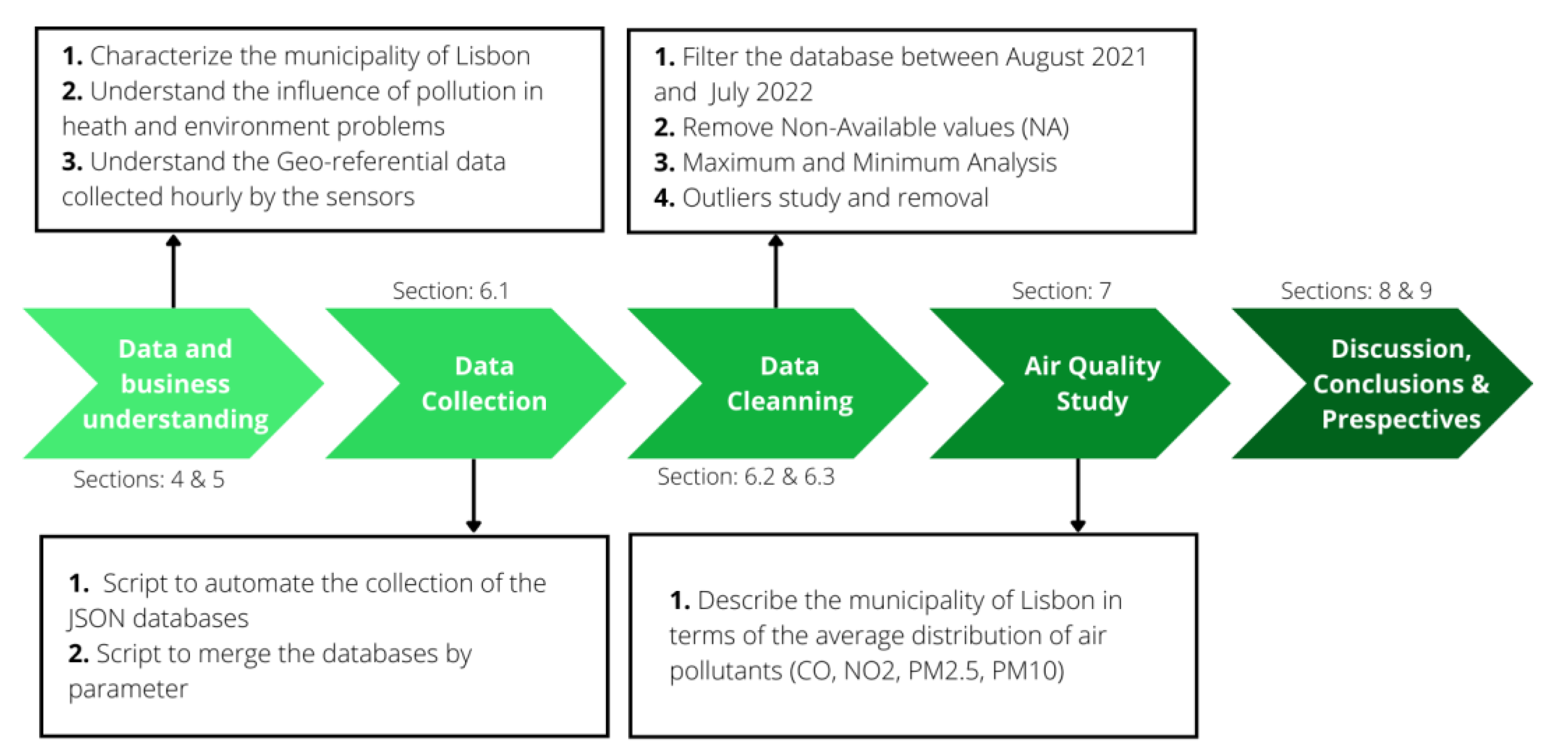


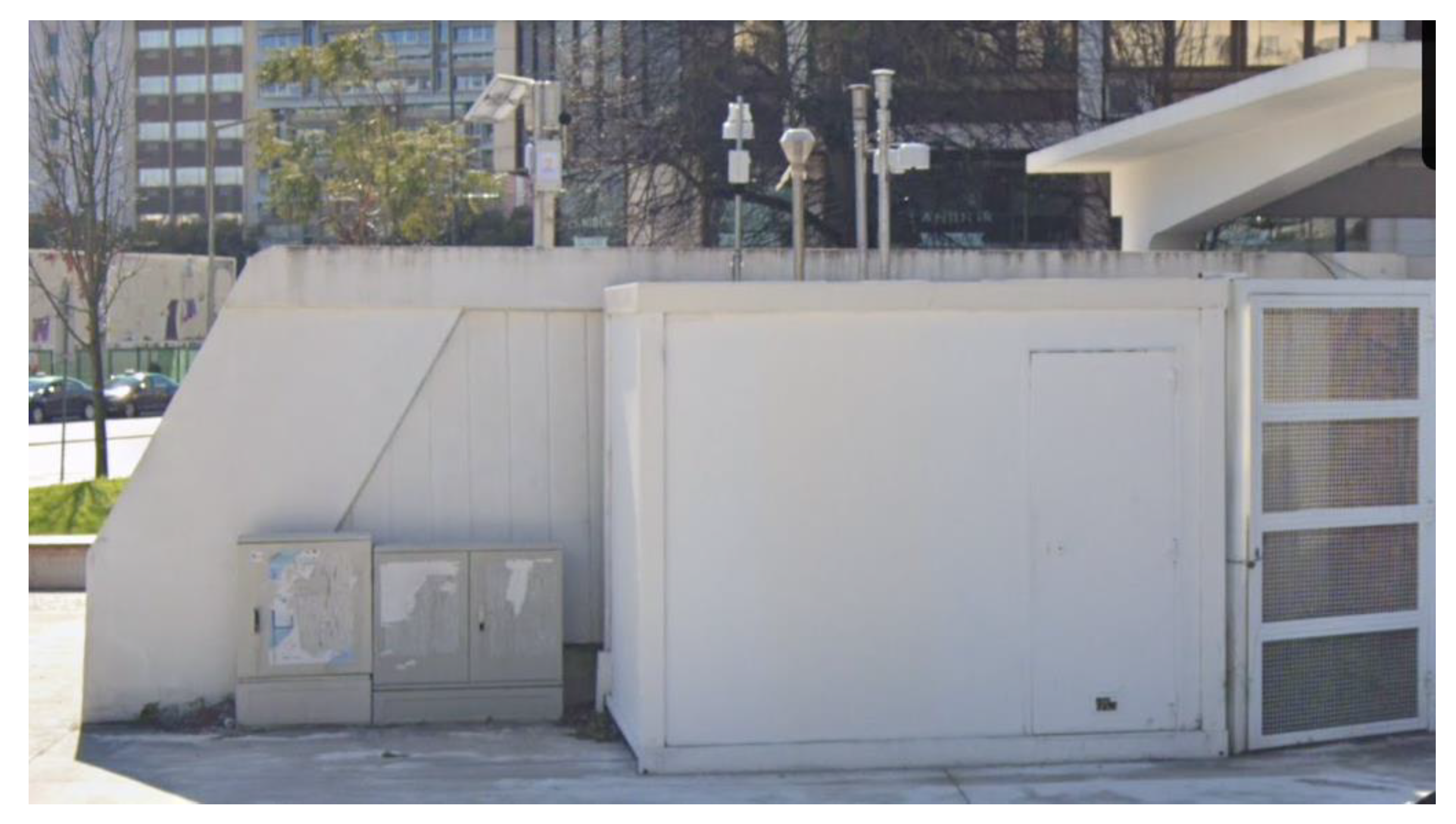

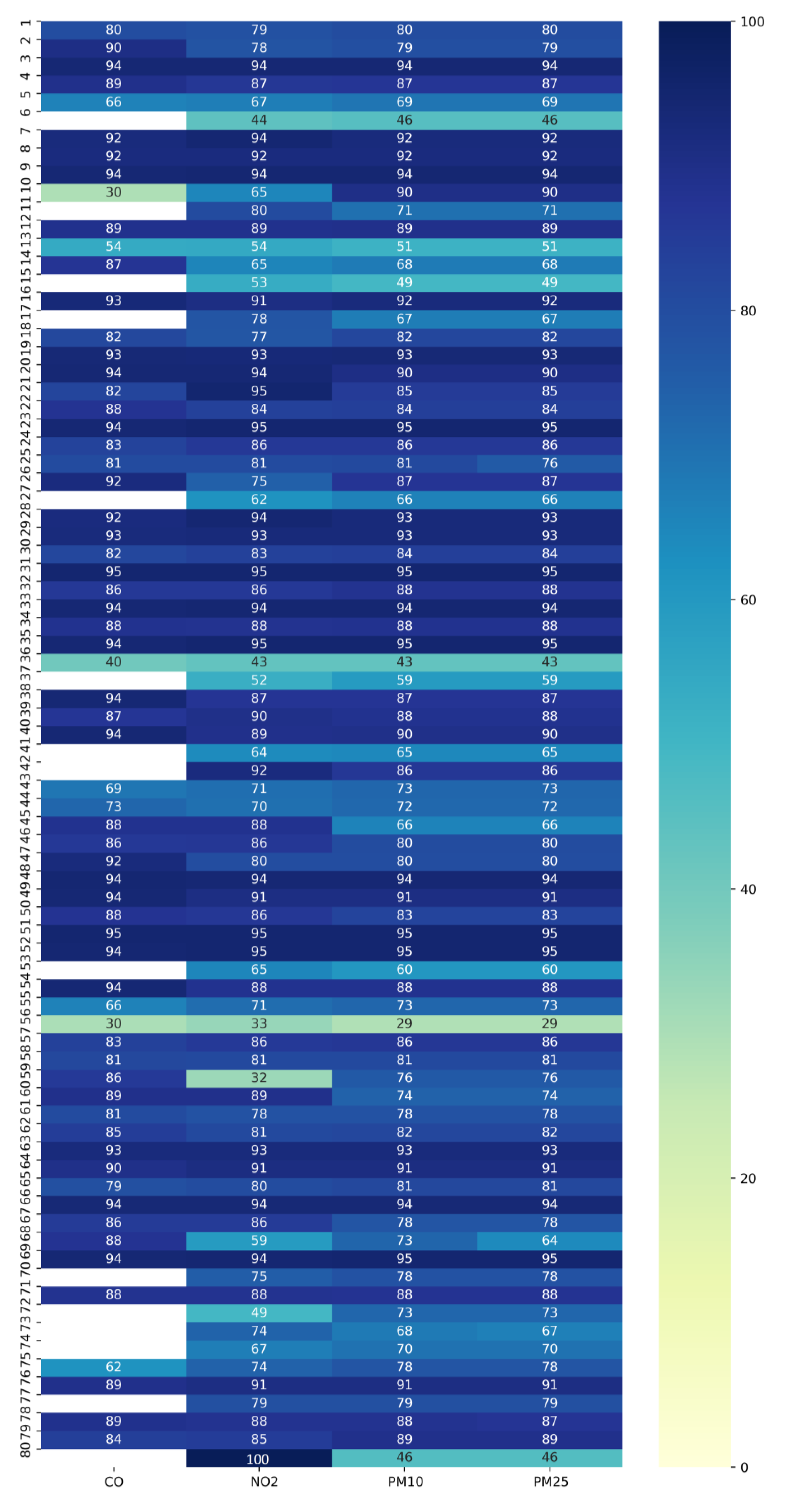



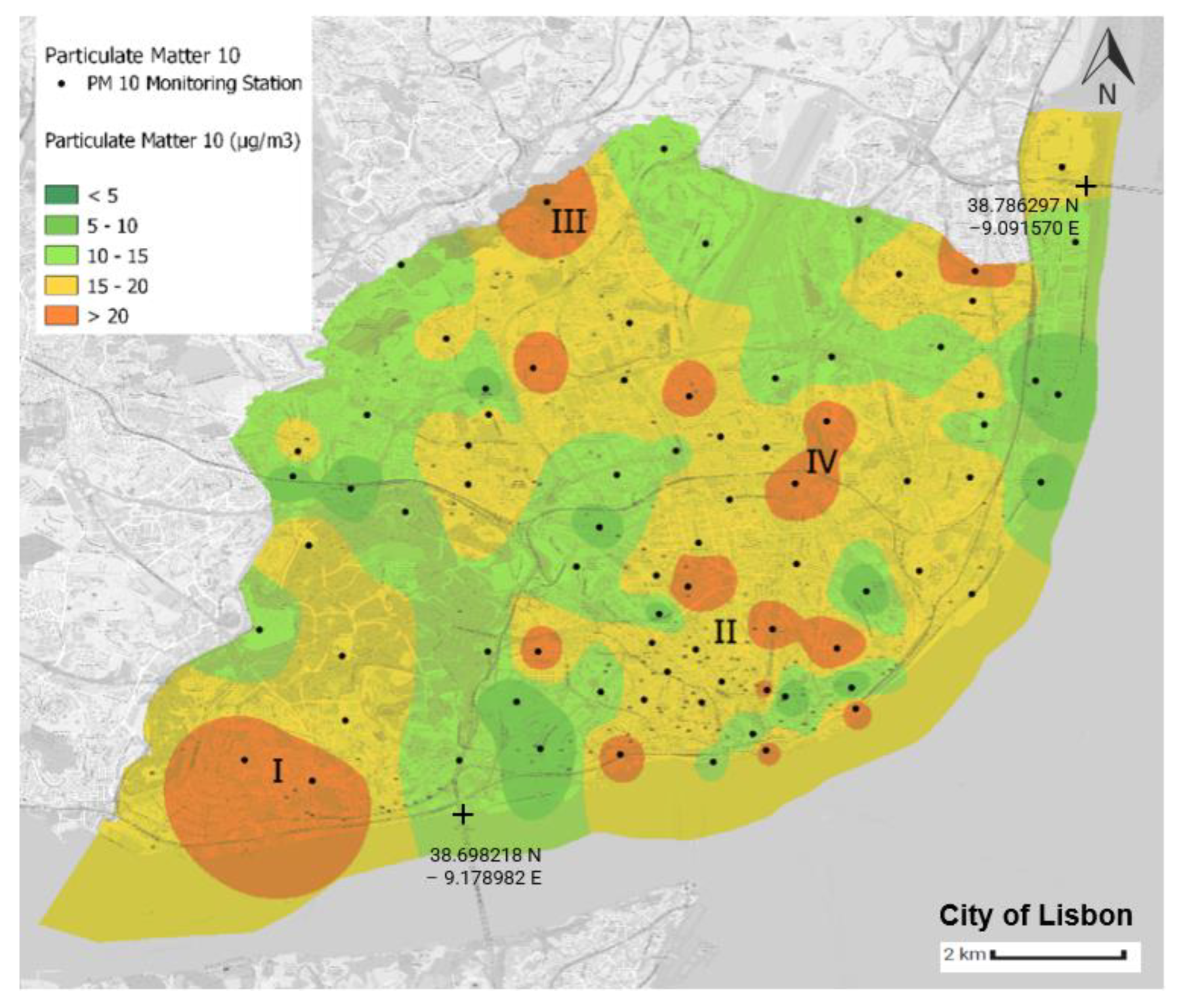
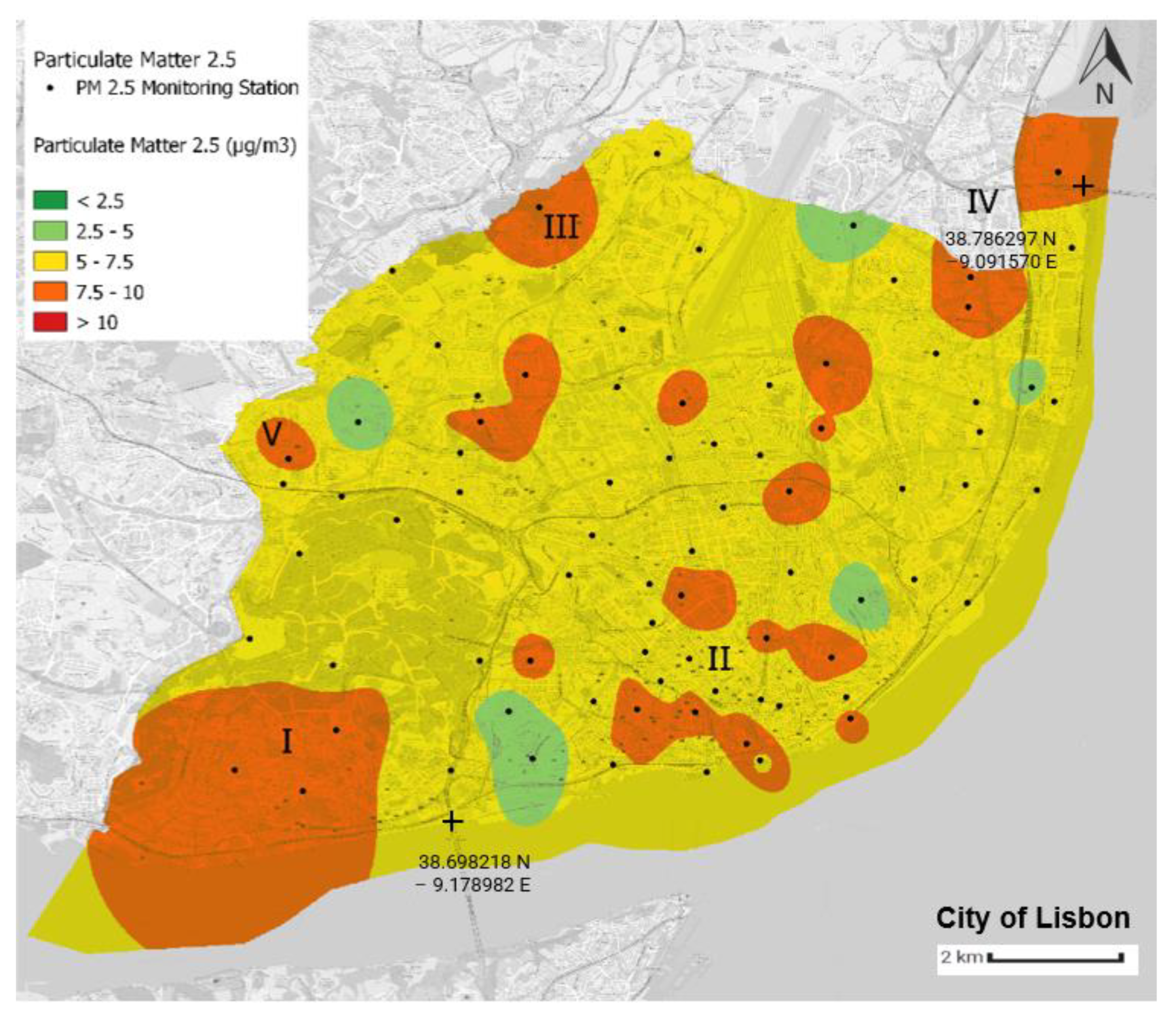
| Parameter | Unit | Size | N. Sensors | NA% | Outliers % |
|---|---|---|---|---|---|
| CO | μg/m3 | 467,057 | 65 | 0.17 | 0.25 |
| NO2 | μg/m3 | 479,646 | 80 | 2.18 | 0.03 |
| PM2.5 | μg/m3 | 518,370 | 80 | 0.00 | 2.51 |
| PM10 | μg/m3 | 519,249 | 80 | 0.00 | 2.64 |
| Parameter | Min (a) | Mean (a) | Max (a) | Min (b) | Mean (b) | Max (b) |
|---|---|---|---|---|---|---|
| CO | 0.0009 | 174.96 | 10,025.75 | 0.0009 | 172.05 | 925.06 |
| NO2 | 1.00 | 73.33 | 8122.00 | 1.00 | 73.12 | 396.00 |
| PM2.5 | −66.00 | 10.88 | 52,852.00 | 0.00 | 6.94 | 29.00 |
| PM10 | −66.00 | 24.53 | 99,096.00 | 0.00 | 16.54 | 69.00 |
| Parameter | Period | Limit Value |
|---|---|---|
| CO | 1 year | 4000 μg/m3 |
| NO2 | 1 year | 10 μg/m3 |
| PM2.5 | 1 year | 5 μg/m3 |
| PM10 | 1 year | 15 μg/m3 |
Disclaimer/Publisher’s Note: The statements, opinions and data contained in all publications are solely those of the individual author(s) and contributor(s) and not of MDPI and/or the editor(s). MDPI and/or the editor(s) disclaim responsibility for any injury to people or property resulting from any ideas, methods, instructions or products referred to in the content. |
© 2023 by the authors. Licensee MDPI, Basel, Switzerland. This article is an open access article distributed under the terms and conditions of the Creative Commons Attribution (CC BY) license (https://creativecommons.org/licenses/by/4.0/).
Share and Cite
Sarroeira, R.; Henriques, J.; Sousa, A.M.; Ferreira da Silva, C.; Nunes, N.; Moro, S.; Botelho, M.d.C. Monitoring Sensors for Urban Air Quality: The Case of the Municipality of Lisbon. Sensors 2023, 23, 7702. https://doi.org/10.3390/s23187702
Sarroeira R, Henriques J, Sousa AM, Ferreira da Silva C, Nunes N, Moro S, Botelho MdC. Monitoring Sensors for Urban Air Quality: The Case of the Municipality of Lisbon. Sensors. 2023; 23(18):7702. https://doi.org/10.3390/s23187702
Chicago/Turabian StyleSarroeira, Rodrigo, João Henriques, Ana M. Sousa, Catarina Ferreira da Silva, Nuno Nunes, Sérgio Moro, and Maria do Carmo Botelho. 2023. "Monitoring Sensors for Urban Air Quality: The Case of the Municipality of Lisbon" Sensors 23, no. 18: 7702. https://doi.org/10.3390/s23187702
APA StyleSarroeira, R., Henriques, J., Sousa, A. M., Ferreira da Silva, C., Nunes, N., Moro, S., & Botelho, M. d. C. (2023). Monitoring Sensors for Urban Air Quality: The Case of the Municipality of Lisbon. Sensors, 23(18), 7702. https://doi.org/10.3390/s23187702







